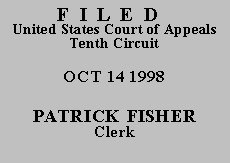

| UNITED STATES OF AMERICA, | |
| Plaintiff - Appellee, | |
| v. | |
| MILDREY M. BRIDGES, | |
| Defendant - Appellant. |
In September 1997, Defendant was indicted on four counts, each of which involved providing contraband to inmates in prison in violation of 18 U.S.C. § 1791(a)(1). At the time of these offenses, Defendant was a corrections officer at the United States Penitentiary in Leavenworth, Kansas. Defendant subsequently entered a plea of guilty to Count I of the indictment, which charged Defendant with providing marijuana to an inmate in prison in violation of 18 U.S.C. § 1791(a)(1). The record indicates that Defendant entered his guilty plea pursuant to a plea agreement. In exchange for his guilty plea, the government agreed to dismiss the remaining counts pending against Defendant, to recommend a sentence at the low end of the applicable guideline range, and to recommend a reduction in his sentence for accepting responsibility for the offense.
In this direct appeal, Defendant argues that the district court erred in calculating his sentence. He claims that, in addition to being sentenced for possessing marijuana and heroin, he was erroneously sentenced for possessing cocaine base, instead of cocaine powder. "Because [Defendant] failed to object to the calculation of the offense level at his sentencing hearing, we review only for plain error."(1) United States v. Herndon, 982 F.2d 1411, 1419 (10th Cir. 1992) (citing Fed. R. Crim. P. 52(b)). Sentencing a defendant on "the wrong guideline range constitutes a fundamental error affecting substantial rights within the meaning of Rule 52(b)." Id.
The transcript of the sentencing hearing demonstrates that Defendant was sentenced for possession of cocaine powder, not cocaine base. See Appellant's App. at 12. Although the district court mentioned the possibility of sentencing Defendant for cocaine base due to his admission at the sentencing hearing that he possessed cocaine base, it elected to follow the presentence report prepared by the United States Probation Office. In the report, Defendant's base offense level was calculated with reference to cocaine powder, not cocaine base.
In accordance with the presentence report, the district court sentenced Defendant for possession of the following: 24 ounces of marijuana, 1 pound of marijuana, 4 grams of heroin, and 4 grams of powder cocaine. Under the conversion tables in section 2D1.1 of the United States Sentencing Guidelines, these amounts convert into equivalent amounts of marijuana as follows:
24 ounces marijuana = 680.4 grams marijuana
1 pound marijuana = 453.6 grams marijuana
4 grams heroin = 4,000 grams marijuana
4 grams cocaine (powder) = 800 grams marijuana
The total amount of marijuana is 5,934 grams, which is the equivalent of 5.934 kilograms. According to the Drug Quantity Table in section 2D1.1 of the Sentencing Guidelines, Defendant's base offense level should be 14. See U.S.S.G. § 2D.1.1(c)(13). We note that if Defendant had been sentenced for even one gram of cocaine base, as he contends, his base offense level would have been 18. One (1) gram of cocaine base is equivalent to 20 kilograms of marijuana, which would increase his total quantity of drugs to roughly 25 kilograms, or 25,000 grams. See U.S.S.G. § 2D1.1(c)(11).
Three adjustments were then made to Defendant's base offense level. First, Defendant received a two-level increase for distributing a controlled substance in prison pursuant to section 2D1.1(b)(3). This increase brought the sentencing level to 16. Second, Defendant received a two-level increase for abusing a position of public trust pursuant to section 3B1.3, which increased the offense level to 18. Finally, Defendant received a reduction of three levels for accepting responsibility for his offense, in accordance with section 3E1.1(b). Thus, the appropriate sentencing level for Defendant was 15, as both the presentencing report and the district court determined. Because Defendant's criminal history category was I, the applicable sentencing range was 18 to 24 months. See U.S.S.G. Sentencing Table, Ch. 5, Pt. A. The district court, following the Government's recommendation of a sentence at the low end of the sentencing range, sentenced Defendant to 18 months.
We conclude that the district court neither calculated Defendant's sentence based on his possession of cocaine base nor erred in calculating Defendant's
offense level and sentence. Accordingly, we AFFIRM the sentence imposed by the district court.
AFFIRMED.
Entered for the Court
Monroe G. McKay
Circuit Judge
*. This order and judgment is not binding precedent, except under the doctrines of law of the case, res judicata, and collateral estoppel. The court generally disfavors the citation of orders and judgments; nevertheless, an order and judgment may be cited under the terms and conditions of 10th Cir. R. 36.3.
1.Our review of the mere two pages of the transcript of the sentencing hearing provided to the court by Defendant indicates that Defendant assented to the court's determinations regarding his sentence. See Appellant's App. at 12.